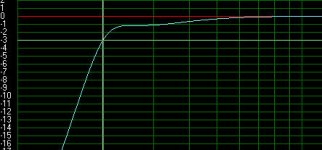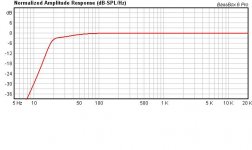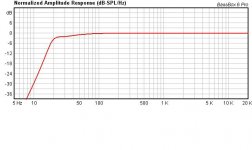I need a sub to go with my Audax HT kit I am building. Instead of spending another $100 to $200 on another sub, I have I have a few car subs laying around the house. The one I plan to use if it will suffice is an Arc Audio 12" dual 4 ohm sub. The specs are as follows:
Nominal Impediance: 2 or 8 ohms (dual 4 ohm coils)
DC Resistance: 3.5 Ohms per coil
Resinant Frequancy: 22Hz
Sensitivity: 89db
RMS Power Handling: 350 watts
Electrical "Q": .317
Total "Q": .289
One Way Linear: 12.5mm
I also have at my disposal a Diamond Audio M6D2 12" sub. Specs are as follows:
Impedance: Dual 4ohm
SPL 1w/1m: 86db
Qes: 0.55
Qts: 0.49
Fs: 31.0 Hz
Vas: 30.3L
Cms (mm/N): 0.087
Mms: 311g
Sd (M2): 0.0497
BL (T-M): 19.0
Re: 3.3
Xmax: 15mm
Would either of these make a good HT sub? If so which would be better?
Thanks,
Daryl
Nominal Impediance: 2 or 8 ohms (dual 4 ohm coils)
DC Resistance: 3.5 Ohms per coil
Resinant Frequancy: 22Hz
Sensitivity: 89db
RMS Power Handling: 350 watts
Electrical "Q": .317
Total "Q": .289
One Way Linear: 12.5mm
I also have at my disposal a Diamond Audio M6D2 12" sub. Specs are as follows:
Impedance: Dual 4ohm
SPL 1w/1m: 86db
Qes: 0.55
Qts: 0.49
Fs: 31.0 Hz
Vas: 30.3L
Cms (mm/N): 0.087
Mms: 311g
Sd (M2): 0.0497
BL (T-M): 19.0
Re: 3.3
Xmax: 15mm
Would either of these make a good HT sub? If so which would be better?
Thanks,
Daryl
I plan on using a car speaker for my diy sub, and i for one see nothing wrong with that. just as long as it can reach those low frequancy i want.
A quick input of the parameters for the Diamond Audio shows it should make a fine HT sub in a ported enclosure. The plot below was with 2.5 cub. ft. ported enclosure tuned at 22 Hz & shows f3 (3 dB down) at about 20 Hz. Can't run a simulation on the Arc Audio because you don't have Vas spec listed but it looks like it could work also but with such a low Qt & it's starting fs of 22 Hz may not tune quite as low as smoothly. Qt's that low generally need to be tuned at least somewhat above fs for decent response curve & power handling. I don't think either would do as well for HT in a sealed enclosure as the fs is a little high for the Diamond & either Qt is to low or fs to high for the Arc.
Nothing wrong with using car audio subs. One thing to consider though is the Diamond efficiency spec SPL 86 dB is pretty low so it will take some juice to drive, which I've noticed as a common weakness among high excursion car audio drivers. With home listening levels should be fine though with 100 watts or so to drive it.
Nothing wrong with using car audio subs. One thing to consider though is the Diamond efficiency spec SPL 86 dB is pretty low so it will take some juice to drive, which I've noticed as a common weakness among high excursion car audio drivers. With home listening levels should be fine though with 100 watts or so to drive it.
Attachments
Thanks Stephen, I was able to come up with very similar results using bass box pro. I think the Diamond will make a good temporary sub, I will get one of the plate amps that are atleast 250 w, and the Diamond sub is a dual 2 ohm so it will get the 250w. When I run simulations, what should I be looking for? I know a good flat response curve, but as far as the Fb and F3, what would be ideal?
Thanks,
D.
Thanks,
D.
An Fb of around 20-40Hz. as you want the box tuned in the area where punchiness for HT will count and the F3 around this range as well. Without EQ though, the box may simulate as having a higher F3 so, you shouldn't be too worried about that as EQ's around the 25-45Hz. range are common and usually extend the flat response about half an octave or so. Though the specs are incomplete for some estimations on perf. and such, the Fb may end up at about 35-40Hz, perfect for your application. Right now I have a Shiva w/100WPlate-amp w/25Hz +-6dB EQ..great sound from a fairly large enclosure though....At 53L. it's on the edge of being too large for most people. This is where the Linkwitz transform comes in.
nuttinbutSQ said:how is this, I was able to get this out of a 2.5 cf with a fb of 21hz and a f3 of 20.4hz. Has a single port of 3"ID X 15.47" long. Please bare with me this a all a new learning experience for me.
I'd say that's dandy. With that low of tuning I don't think you'd have to worry about putting a high pass filter to protect against infrasonic below the port tuning causing excessive wasted excursion & you've gone plenty deep enough to enjoy every earth quake & bomb blast HT can hit you with. I might suggest trying to fit a larger diameter port in though (which then would also be longer) because at 3" the port air velocity will be pretty excessive at high SPL in that range & could cause audible port noise not to mention some power compression. One complication of ported cabs with low fb's is the ports can get very long. For a 4" port WinISD shows 27.66" for a 2.5 cf enclosure with fb of 21 Hz! Would need to curve the port with elbows or make wood rectangle port following cabinet walls or something like that. Also remember, port volume & speaker displacement volume are added to calculated enclosure volume to give actual final volume of enclosure.
Flat response is one thing to aim for but it's not the only thing & not really a priority as it can be EQ'd. Other things to look for are max SPL, cone excursion & extended bass response. Often we sacrifice a little flatness in response curve to optimize something else like extended bass range, max SPL over a certain range or even enclosure size limitation.
I ran a simulated SPL plot at 250 watts with that speaker & enclosure & WinISD shows 105.66 dB/1 meter at 20 HZ & roughly flattens out to about 107.7 dB at 50 Hz & above.
Did a cone excursion plot at 250 watts & it doesn't max out till about 17 Hz. 20 Hz & above is nowhere close to approaching Xmax.
Should be pretty kick but HT sub. Go for it.
Thanks for your help, I did a few more calculations to try and squeese a 4" port in, I thought 3 could have some port noise. But any how I had to increase the enclosure size to a 3cf cube design that is 17.64" (internal dimentions) all the way around. A single 4" port that is 22.14" in length. I will have to put a bend in it but that is not a problem. The final parameters vb: 3cu.ft, fb: 21hz, and F3 of 20.9hz. Here is my final graph. If all goes well I won't even have to change this sub. Thanks again for your help and guidance in the right direction.
Attachments
Bose(o) said:I was referring to a sealed enclosure as I'd thought that's what you wanted
I just wanted an enclosure that would give me the best low end I could get out of the subs I have. Sealed are very easy to build, generally have a flater response (except in this case as the sub will only be playing from around 50 to 60hz down). So in this case ported is the way to go, a bit more difficult to build and some what larger, I was able to get a good response all the way down to 20hz.
thanks,
D.
nuttinbutSQ said:enclosure size to a 3cf cube design that is 17.64" (internal dimentions) all the way around. A single 4" port that is 22.14" in length.
So, with a calculated tuned box volume of 3 cf now ya must add the port & speaker displacement volume to that to get your final actual box volume & dimensions to work with that your port actually fits into so to speak. Converting to cub" we get -
Tuned box volume = 5184 cub"
port volume (cross sectional area times length) = (remember cabinet wall thickness is part of port length so if walls are typical 3/4") thats 12.566 x (22.14 - .75) = 268.79 cub"
Speaker displacement volume (magnet structure etc.) = ?? cub"
(since I don't know the displacement of your speaker, for the sake of demonstration, I'll just rough guestimate about 125 cub" which is roughly average for a 300 watt RMS 12" car woofer).
Adding we get 5184 + 268.79 + 125 = 5577.79 cub" (or 3.23 cf) actual final internal box volume.
Couple things -
Although that's a fairly large box, I consider it a common misconception that sealed enclosures yield smaller boxes, because to reach the same max SPL at the bottom octave you have there, with a sealed box it would take a speaker with nearly twice the cone area or multiple speakers which end result is total enclosure volume per achievable SPL in the bottom octave is not significantly better with sealed, Plus it takes added cost of bigger or more drivers.
If you wanted to chip away an inch or so more here & there from box &/or port dimensions you could consider raising fb a few Hz to say as far as 24 Hz. What you would loose in a few Hz of low end extension you would gain in flatness down to the slightly higher f3 & a little more support from the port air up into the upper 20 to lower 30 Hz range where there is definitely more program material than below 20 HZ (though with the excursion capability of that speaker it's definitely not suffering from need of more port air support up there). That's a judgment call you'll have to make, but if your fine with the dimensions you have I'd say it's a keeper & doubt you'll be feeling the need to build a replacement in the near future once it's done. Seems ya lucked out with a spare speaker layin' around that's pretty near made to order for your task. 😉
You're on the right track, just watch out for port speed (turbulence ie, the chuffing sound you may hear from poorly designed speakers) and vent length: As long as you can fit it within the enclosure with the least amount of folding you should be fine.
Now, don't let me get in you way, as you're learning the way I did--just trying some stuff and determining what is good and what is bad.
Now, don't let me get in you way, as you're learning the way I did--just trying some stuff and determining what is good and what is bad.
Stephen D said:
So, with a calculated tuned box volume of 3 cf now ya must add the port & speaker displacement volume to that to get your final actual box volume & dimensions to work with that your port actually fits into so to speak. Converting to cub" we get -
Tuned box volume = 5184 cub"
port volume (cross sectional area times length) = (remember cabinet wall thickness is part of port length so if walls are typical 3/4") thats 12.566 x (22.14 - .75) = 268.79 cub"
Speaker displacement volume (magnet structure etc.) = ?? cub"
(since I don't know the displacement of your speaker, for the sake of demonstration, I'll just rough guestimate about 125 cub" which is roughly average for a 300 watt RMS 12" car woofer).
Adding we get 5184 + 268.79 + 125 = 5577.79 cub" (or 3.23 cf) actual final internal box volume.
Couple things -
Although that's a fairly large box, I consider it a common misconception that sealed enclosures yield smaller boxes, because to reach the same max SPL at the bottom octave you have there, with a sealed box it would take a speaker with nearly twice the cone area or multiple speakers which end result is total enclosure volume per achievable SPL in the bottom octave is not significantly better with sealed, Plus it takes added cost of bigger or more drivers.
If you wanted to chip away an inch or so more here & there from box &/or port dimensions you could consider raising fb a few Hz to say as far as 24 Hz. What you would loose in a few Hz of low end extension you would gain in flatness down to the slightly higher f3 & a little more support from the port air up into the upper 20 to lower 30 Hz range where there is definitely more program material than below 20 HZ (though with the excursion capability of that speaker it's definitely not suffering from need of more port air support up there). That's a judgment call you'll have to make, but if your fine with the dimensions you have I'd say it's a keeper & doubt you'll be feeling the need to build a replacement in the near future once it's done. Seems ya lucked out with a spare speaker layin' around that's pretty near made to order for your task. 😉
Bassbox Pro takes into account speaker and port displacement. The actual internal volume of the enclosure is 3.176cu.ft. The only thing I might try is a bit smaller port. I will try a 3" ID and run some test tone and slap about a 1000 watts to and see if I get any port noise. And that sub isn't actually laying around, it's currently in my High End truck install. I bought it as a temp sub, this just gives me a reason to get my OZ sub I want. 😀
- Status
- Not open for further replies.
- Home
- Loudspeakers
- Subwoofers
- Would this sub be any good for HT use


